 |
| |
Switch to: Europe, USA, New Zealand, Antarctica
Credit: NOAA/Ovation
 Planetary K-index
Planetary K-index
Now: Kp=
4.67 unsettled
24-hr max: Kp= 4.67 unsettled
explanation | more
data
Interplanetary Mag. Field
Btotal: 6.23 nT
Bz: -5.05 nT south
more data: ACE, DSCOVR
Updated: Today at 0546 UT
 Coronal Holes: 22 Feb 23
Coronal Holes: 22 Feb 23

Solar wind flowing from this equatorial coronal hole could reach Earth on Feb 27-28. Credit: SDO/AIA
 Noctilucent Clouds
Noctilucent Clouds
The southern hemisphere season for
noctilucent clouds has begun. NASA's AIM spacecraft detected the first
electric-blue puffs over Antarctica on Dec. 1st.
Switch view:Ross Ice Shelf, Antarctic Peninsula, East Antarctica, Polar
Updated
Feb22

SPACE WEATHER
NOAA Forecasts |
|
Updated at: 2023 Feb 22 2200 UTC
FLARE |
0-24
hr |
24-48
hr |
CLASS M |
50
% |
50
% |
CLASS X |
10
% |
10
% |
 Geomagnetic Storms:
Geomagnetic Storms:
Probabilities for significant
disturbances in Earth's magnetic field are given for three activity levels: active, minor
storm, severe
storm
Updated at: 2023 Feb 22 2200 UTC
Mid-latitudes
|
0-24
hr |
24-48
hr |
ACTIVE |
20
% |
20
% |
MINOR |
05
% |
05
% |
SEVERE |
01
% |
01
% |
High latitudes
|
0-24
hr |
24-48
hr |
ACTIVE |
20
% |
15
% |
MINOR |
25
% |
25
% |
SEVERE |
25
% |
25
% |
|
|
|
 |
|
|
|
| |
|
|
|
| |
Never miss another geomagnetic storm. Sign up for Space Weather Alerts
and you'll receive a text message when magnetic storms erupt. Aurora
tour guides and professional astronomers use this service. You can, too!
|
|
|
NO CMES ARE HEADING OUR WAY: For the past three days, the sun has produced a non-stop fusillade
of solar flares. Yet no CMEs are heading our way. Why not? The source
of the explosions, sunspot AR3234, was not facing Earth. This is about
to change, however, as the the sun's rotation turns the sunspot more
directly toward our planet. Solar flare alerts: SMS Text.
SUNSET SKY SHOW: Around
the world, people are watching Venus, Jupiter, and the crescent Moon
line up in the sunset sky. Jan Jackson took this picture last night in
Ziheautanejo, Mexico:

"The planets were so bright, we could photograph them with nothing more than a cell phone," says Jackson.
There's something different to see every night. Tonight, the Moon moves up and passes close to Jupiter (Pro tip: Be alert for Earthshine.) Tomorrow, there will be a nearly-vertical Moon-Jupiter-Venus line in the sky. Sky maps: Feb. 21, 22, 23.
Best of all, Venus and Jupiter
are converging. At closest approach on March 1st, Venus and
Jupiter will be just 0.5 degrees apart--a beautiful pairing and
one of the best astrophoto-ops of 2023. Take a look and submit your photos here.
more images: from Hari Kumar of Trivandrum, India; from Daniele Gasparri of Nellim, Finland; from Petr Horálek (Institute of Physics in Opava) in Thoddoo, Maldives; from Peter Zimnikoval of Banska Bystrica, Slovakia; from Marko Posavec of Virje, Croatia
Realtime Space Weather Photo Gallery
Free: Spaceweather.com Newsletter
SOLAR ECLIPSE CRYSTAL PYRAMID: On Aug. 21, 2017, during the Great American Solar Eclipse, the students of Earth to Sky Calculus
launched 11 space weather balloons from the path of totality. The
armada soared into the stratosphere, touching the shadow of the
Moon more than 100,000 feet above Earth's surface. This pyramid hitched a
ride:

You can have it for $159.95.
With the sun, Earth, and Moon perfectly aligned, the faces of the
5-sided crystal caught the reflection of the eclipsed sun. Watch the video!
The pyramid comes with a gift card showing the crystal floating at
the top of Earth's atmosphere and passing through the Moon's shadow.
The interior of the card tells the story of the flight and confirms
that this gift has been to the edge of space and back again.
Far Out Gifts: Earth to Sky Store
All sales support hands-on STEM education
Realtime Aurora Photo Gallery
Free: Spaceweather.com Newsletter
Every night, a network
of NASA
all-sky cameras scans the skies above the United
States for meteoritic fireballs. Automated software
maintained by NASA's Meteoroid Environment Office
calculates their orbits, velocity, penetration depth
in Earth's atmosphere and many other characteristics.
Daily results are presented here on Spaceweather.com.
On Feb 22 2023, the network reported 8 fireballs.
(8 sporadics)

In this diagram of the inner solar system, all of the fireball orbits intersect at a single point--Earth. The orbits are color-coded by velocity, from slow (red) to fast (blue).
[Larger image] [movies]
Potentially Hazardous Asteroids ( PHAs)
are space rocks larger than approximately 100m that
can come closer to Earth than 0.05 AU. None of the
known PHAs is on a collision course with our planet,
although astronomers are finding new
ones all the time.
On February 23, 2023 there were 2331 potentially hazardous asteroids.
 |
Recent
& Upcoming Earth-asteroid encounters:
| Asteroid |
Date(UT) |
Miss Distance |
Velocity (km/s) |
Diameter (m) |
| 2023 CA3 |
2023-Feb-17 |
5.9 LD |
12.4 |
14 |
| 2023 CS3 |
2023-Feb-17 |
9.4 LD |
4.7 |
15 |
| 2023 CY1 |
2023-Feb-17 |
4.6 LD |
6.7 |
20 |
| 2023 CW2 |
2023-Feb-17 |
1.6 LD |
2.3 |
4 |
| 2020 DG4 |
2023-Feb-17 |
1.4 LD |
6.9 |
8 |
| 2023 CC1 |
2023-Feb-18 |
15 LD |
12.2 |
41 |
| 2023 DN |
2023-Feb-18 |
2.6 LD |
6.2 |
20 |
| 2023 CS2 |
2023-Feb-18 |
4.3 LD |
7.6 |
9 |
| 2023 DH |
2023-Feb-18 |
6.6 LD |
4.9 |
10 |
| 2023 CE2 |
2023-Feb-18 |
13.6 LD |
16.1 |
28 |
| 2023 CH1 |
2023-Feb-18 |
7.6 LD |
7.5 |
17 |
| 2023 CW |
2023-Feb-18 |
6.7 LD |
7.6 |
26 |
| 2020 CX1 |
2023-Feb-19 |
17.4 LD |
7.7 |
53 |
| 2023 DC |
2023-Feb-20 |
8.6 LD |
7.8 |
12 |
| 2023 CR2 |
2023-Feb-20 |
19.2 LD |
17.3 |
21 |
| 2023 DJ |
2023-Feb-20 |
19.6 LD |
12.4 |
75 |
| 2023 DF |
2023-Feb-21 |
4.3 LD |
9.8 |
14 |
| 37638 |
2023-Feb-21 |
17 LD |
11.1 |
493 |
| 2023 AA2 |
2023-Feb-22 |
17.4 LD |
10.1 |
133 |
| 2023 CM2 |
2023-Feb-22 |
2.1 LD |
11.2 |
22 |
| 2023 DE |
2023-Feb-22 |
8.6 LD |
16.9 |
25 |
| 2023 CS1 |
2023-Feb-23 |
15.1 LD |
9.1 |
31 |
| 2023 DK |
2023-Feb-25 |
6.6 LD |
4 |
9 |
| 2023 CG1 |
2023-Feb-25 |
15.2 LD |
6.5 |
32 |
| 2023 DA |
2023-Feb-26 |
2.8 LD |
5.9 |
18 |
| 2023 CX2 |
2023-Feb-27 |
7.6 LD |
2.3 |
11 |
| 2023 CC2 |
2023-Feb-27 |
16.2 LD |
5.1 |
31 |
| 2012 DK31 |
2023-Feb-27 |
12.6 LD |
15.5 |
143 |
| 2006 BE55 |
2023-Feb-28 |
9.4 LD |
13.3 |
145 |
| 2021 QW |
2023-Mar-03 |
13.9 LD |
12.1 |
79 |
| 2017 BM123 |
2023-Mar-03 |
12.1 LD |
7.8 |
61 |
| 2007 ED125 |
2023-Mar-03 |
11.7 LD |
13.1 |
224 |
| 2015 EG |
2023-Mar-04 |
13.9 LD |
10.6 |
27 |
| 2023 BK5 |
2023-Mar-05 |
17.8 LD |
8.4 |
62 |
| 535844 |
2023-Mar-07 |
10.5 LD |
7.7 |
149 |
| 2020 FQ |
2023-Mar-09 |
14 LD |
6.3 |
13 |
| 2020 FV4 |
2023-Mar-13 |
17.6 LD |
8.2 |
30 |
| 2023 CM |
2023-Mar-14 |
10.3 LD |
14 |
190 |
| 2023 DM |
2023-Mar-15 |
8.5 LD |
7.4 |
65 |
| 2018 UQ1 |
2023-Mar-17 |
10.7 LD |
11.7 |
143 |
| 2016 WH |
2023-Mar-19 |
18.1 LD |
11.8 |
14 |
| 2018 FE3 |
2023-Mar-21 |
10.1 LD |
5.4 |
13 |
| 2023 CE4 |
2023-Mar-29 |
20 LD |
10.1 |
93 |
| 2022 YK4 |
2023-Mar-29 |
11.9 LD |
2.3 |
25 |
| 2017 SE12 |
2023-Mar-30 |
5.2 LD |
8.4 |
15 |
| 2016 GH1 |
2023-Mar-30 |
7.7 LD |
5.8 |
11 |
| 2022 GO3 |
2023-Apr-02 |
17 LD |
11.6 |
15 |
| 2021 GN1 |
2023-Apr-02 |
17.7 LD |
14.2 |
18 |
| 2018 FD |
2023-Apr-07 |
17.9 LD |
8.2 |
47 |
| 2019 GK21 |
2023-Apr-13 |
15.2 LD |
8.1 |
27 |
| 2022 YK9 |
2023-Apr-13 |
19.9 LD |
9.9 |
175 |
| 436774 |
2023-Apr-13 |
12.5 LD |
17.6 |
719 |
 |
Notes: LD means
"Lunar Distance." 1 LD = 384,401 km, the distance
between Earth and the Moon. 1 LD also equals 0.00256
AU.
| |
Cosmic Rays in the Atmosphere |
SPACE WEATHER BALLOON DATA: Almost once a week, Spaceweather.com and the students of Earth to Sky Calculus
fly space weather balloons to the stratosphere over California. These
balloons are equipped with sensors that detect secondary cosmic rays, a
form of radiation from space that can penetrate all the way down to
Earth's surface. Our monitoring program has been underway without
interruption for 7 years, resulting in a unique dataset of in situ atmospheric measurements.
Latest results (July 2022): Atmospheric radiation is decreasing in 2022. Our latest measurements in July 2022 registered a 6-year low:

What's going on? Ironically, the radiation drop is caused by increasing solar activity. Solar Cycle 25 has roared to life
faster than forecasters expected. The sun's strengthening and
increasingly tangled magnetic field repels cosmic rays from deep space.
In addition, solar coronal mass ejections (CMEs) sweep aside cosmic
rays, causing sharp reductions called "Forbush Decreases." The two effects blend together to bring daily radiation levels down.
.Who
cares? Cosmic rays are a surprisingly "down to Earth" form of space
weather. They can alter the chemistry of the atmosphere, trigger lightning, and penetrate commercial airplanes. According to a study
from the Harvard T.H. Chan school of public health, crews of
aircraft have higher rates of cancer than the general population. The
researchers listed cosmic rays, irregular sleep habits, and chemical contaminants as leading risk factors. A number of controversial studies (#1, #2, #3, #4) go even further, linking cosmic rays with cardiac arrhythmias and sudden cardiac death.
Technical notes: The radiation sensors onboard our helium balloons detect X-rays and gamma-rays in the energy range 10 keV to 20 MeV. These energies span the range of medical X-ray machines and airport security scanners.
Data points in the graph labeled "Stratospheric Radiation" correspond to the peak of the Regener-Pfotzer maximum,
which lies about 67,000 feet above central California. When cosmic
rays crash into Earth's atmosphere,
they produce a spray of secondary particles that is most intense at
the entrance to the stratosphere. Physicists Eric Regener and Georg
Pfotzer discovered the maximum using balloons in the 1930s and it is what we are measuring today.
| |
The
official U.S. government space weather bureau |
| |
The
first place to look for information about sundogs,
pillars, rainbows and related phenomena. |
| |
Researchers
call it a "Hubble for the sun." SDO
is the most advanced solar observatory ever. |
| |
3D
views of the sun from NASA's Solar and Terrestrial
Relations Observatory |
| |
Realtime
and archival images of the Sun from SOHO. |
| |
information about sunspots based on the latest NOAA/USAF Active Region Summary |
| |
current counts of failed and deployed Starlink satellites from Jonathan's Space Page |
| |
Authoritative predictions of space junk and satellite re-entries |
| |
from
the NOAA Space Environment Center |
| |
fun to read, but should be taken with a grain of salt! Forecasts looking ahead more than a few days are often wrong. |
| |
from the NOAA Space Environment Center |
| |
the
underlying science of space weather |
 |
BestCSGOGambling is the best site for everything related to CSGO gambling on the web |
 |
To find reviews of new online casino sites in the UK try The Casino DB where there are hundreds of online casino reviews complete with bonuses and ratings. Alternatively, Online-Casinos.xyz is another massive directory of online casinos listing sites for the UK and Worldwide.
Casinos that offer Rupees for bonuses are very generous to Indian players. Find the best online casinos in India at AllCasinos.in
Looking for a new online casino? Try Casimpo the new site dedicated to making online casino simple, or check out the new Avenger Slots Casino and Ace Online Casino with over 500 online slots and casino games. |
 |
When looking for casinos to play online when the weather is bad, you can try casino online trucchi
for Italian games. If you are not from Finland you can try the
Swedish page Svenska casino online to find suitable games, check out svenskacasinoonline.net. Always check your local laws before playing with real money. |
 |
Looking for sports betting companies not registered on GamStop? CasinoGap has presented a list of sites not on GamStop available for UK players. Check and bet online!
Would you like to bet at sites not using GamStop? Look at a list of NonStopCasino sites for online betting that aren't on GamStop. Top-rated bookmakers ever! |
| |
These links help Spaceweather.com stay online. Thank you to our supporters! |
| | |














No comments:
Post a Comment